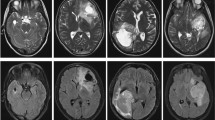Abstract
Gliomas are the most common and severe malignant tumors of the brain. The diagnosis and grading of gliomas are typically based on MRI images and pathology images. To improve the diagnosis accuracy and efficiency, we intend to design a framework for computer-aided diagnosis combining the two modalities. Without loss of generality, we first take an individual network for each modality to get the features and fuse them to predict the subtype of gliomas. For MRI images, we directly take a 3D-CNN to extract features, supervised by a cross-entropy loss function. There are too many normal regions in abnormal whole slide pathology images (WSI), which affect the training of pathology features. We call these normal regions as noise regions and propose two ideas to reduce them. Firstly, we introduce a nucleus segmentation model trained on some public datasets. The regions that has a small number of nuclei are excluded in the subsequent training of tumor classification. Secondly, we take a noise-rank module to further suppress the noise regions. After the noise reduction, we train a gliomas classification model based on the rest regions and obtain the features of pathology images. Finally, we fuse the features of the two modalities by a linear weighted module. We evaluate the proposed framework on CPM-RadPath2020 and achieve the first rank on the validation set.
Access this chapter
Tax calculation will be finalised at checkout
Purchases are for personal use only
Similar content being viewed by others
References
Computational Precision Medicine Radiology-Pathology challenge on Brain Tumor Classification (2020). https://www.med.upenn.edu/cbica/cpm2020.html
Bakas, S., et al.: Identifying the Best Machine Learning Algorithms for Brain Tumor Segmentation, Progression Assessment, and Overall Survival Prediction in the BRATS Challenge (2018)
Kumar, N., et al.: A multi-organ nucleus segmentation challenge. IEEE Trans. Med. Imaging 39, 5 (2017)
Choi, K.S., et al.: Prediction of IDH genotype in gliomas with dynamic susceptibility contrast perfusion MR imaging using an explainable recurrent neural network. NEURO-ONCOLOGY 21, 9 (2019)
Decuyper, M., et al.: Automated MRI based pipeline for glioma segmentation and prediction of grade, IDH mutation and 1p19q co-deletion. MIDL 2020 (2020)
Li, Y., et al.: Classification of breast cancer histology images using multi-size and discriminative patches based on deep learning. IEEE Access 7, 21400–21408 (2019)
Das, K., et al.: Multiple instance learning of deep convolutional neural networks for breast histopathology whole slide classification. In: 15th International Symposium on Biomedical Imaging (2018)
Hashimoto, N., et al: Multi-scale domain-adversarial Multiple-instance CNN for cancer subtype classification with unannotated histopathological images. In: CVPR 2020 (2020)
Sharma, K., Donmez, P., Luo, E., Liu, Y., Yalniz, I.Z.: NoiseRank: unsupervised label noise reduction with dependence models. In: Vedaldi, A., Bischof, H., Brox, T., Frahm, J.-M. (eds.) ECCV 2020. LNCS, vol. 12372, pp. 737–753. Springer, Cham (2020). https://doi.org/10.1007/978-3-030-58583-9_44
Kurc, T., et al.: Segmentation and classification in digital pathology for glioma research: challenges and deep learning approaches. Front. Neurosci. 14, 1–15 (2020). https://doi.org/10.3389/fnins.2020.00027
Pei, L., et al.: Brain tumor classification using 3D convolutional neural network. In: MICCAI 2019 Workshop (2019)
Weng, Y.-T., et al.: Automatic classification of brain tumor types with the mri scans and histopathology images. In: MICCAI 2019 Workshop (2019)
Van Griethuysen, J.J.M., et al.: Computational radiomics system to decode the radiographic phenotype. Cancer Res. 77, 21 (2017)
Yang, Y., et al.: Brain tumor classification with tumor segmentations and a dual path residual convolutional neural network from MRI and pathology images. In: MICCAI 2019 Workshop (2019)
Ma, X., et al.: Brain tumor classification with multimodal MR and pathology images. In: MICCAI 2019 Workshop (2019)
Huang, G., et al.: Densely connected convolutional networks. Computer Era. In: Proceedings of the IEEE Conference on Computer Vision and Pattern Recognition, pp. 4700–4708 (2017)
Tellez, D., et al.: Quantifying the effects of data augmentation and stain color normalization in convolutional neural networks for computational pathology. Med. Image Anal. 58, 101544 (2019)
Chenni, W., et al.: Patch Clustering for Representation of Histopathology Images. Springer, Cham (2019). https://doi.org/10.1007/978-3-030-23937-4_4
Liu, Y., et al.: Detecting Cancer Metastases on Gigapixel Pathology Images. In: MICCAI Tutorial (2017)
Abadi, M., et al.: TensorFlow: a system for large-scale machine learning. Oper. Syst. Des. Implementation 2016 (2016)
Chen, T., et al.: MXNet: a flexible and efficient machine learning library for heterogeneous distributed systems. arXiv preprint arXiv:1512.01274 (2015)
Niu, F., et al.: HOGWILD!: a lock-free approach to parallelizing stochastic gradient descent. In: Advances in Neural Information Processing Systems, vol. 24 (2011)
Acknowledgements
This work was supported by the National Natural Science Foundation of China under Grant 61472393.
Author information
Authors and Affiliations
Corresponding author
Editor information
Editors and Affiliations
Rights and permissions
Copyright information
© 2021 Springer Nature Switzerland AG
About this paper
Cite this paper
Yin, B., Cheng, H., Wang, F., Wang, Z. (2021). Brain Tumor Classification Based on MRI Images and Noise Reduced Pathology Images. In: Crimi, A., Bakas, S. (eds) Brainlesion: Glioma, Multiple Sclerosis, Stroke and Traumatic Brain Injuries. BrainLes 2020. Lecture Notes in Computer Science(), vol 12659. Springer, Cham. https://doi.org/10.1007/978-3-030-72087-2_41
Download citation
DOI: https://doi.org/10.1007/978-3-030-72087-2_41
Published:
Publisher Name: Springer, Cham
Print ISBN: 978-3-030-72086-5
Online ISBN: 978-3-030-72087-2
eBook Packages: Computer ScienceComputer Science (R0)





